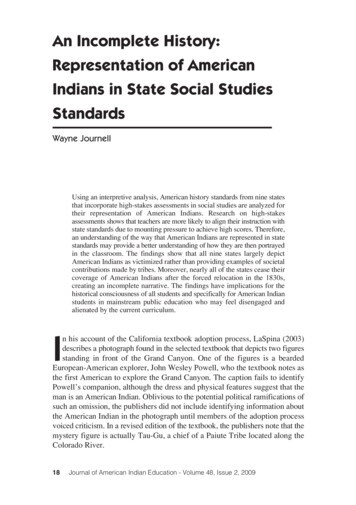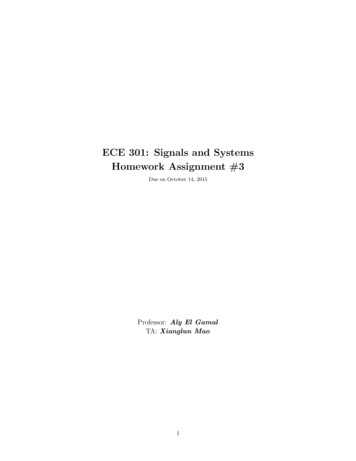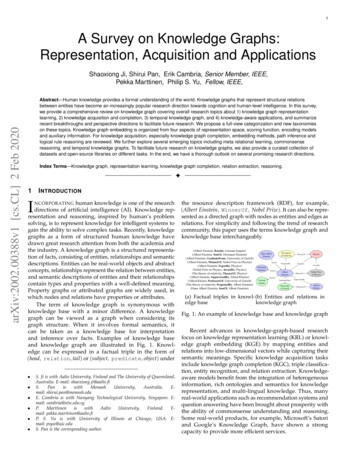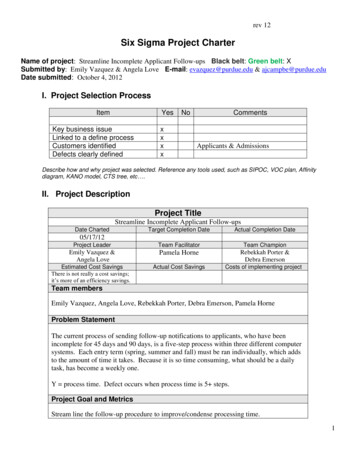
Transcription
An Incomplete History:Representation of AmericanIndians in State Social StudiesStandardsWayne JournellUsing an interpretive analysis, American history standards from nine statesthat incorporate high-stakes assessments in social studies are analyzed fortheir representation of American Indians. Research on high-stakesassessments shows that teachers are more likely to align their instruction withstate standards due to mounting pressure to achieve high scores. Therefore,an understanding of the way that American Indians are represented in statestandards may provide a better understanding of how they are then portrayedin the classroom. The findings show that all nine states largely depictAmerican Indians as victimized rather than providing examples of societalcontributions made by tribes. Moreover, nearly all of the states cease theircoverage of American Indians after the forced relocation in the 1830s,creating an incomplete narrative. The findings have implications for thehistorical consciousness of all students and specifically for American Indianstudents in mainstream public education who may feel disengaged andalienated by the current curriculum.In his account of the California textbook adoption process, LaSpina (2003)describes a photograph found in the selected textbook that depicts two figuresstanding in front of the Grand Canyon. One of the figures is a beardedEuropean-American explorer, John Wesley Powell, who the textbook notes asthe first American to explore the Grand Canyon. The caption fails to identifyPowell’s companion, although the dress and physical features suggest that theman is an American Indian. Oblivious to the potential political ramifications ofsuch an omission, the publishers did not include identifying information aboutthe American Indian in the photograph until members of the adoption processvoiced criticism. In a revised edition of the textbook, the publishers note that themystery figure is actually Tau-Gu, a chief of a Paiute Tribe located along theColorado River.18Journal of American Indian Education - Volume 48, Issue 2, 2009
This oversight serves as a microcosmic view of the way American Indiansand Alaska Natives continue to be portrayed in American public education.Besides the omission of Tau-Gu, the caption identifies Powell as the firstAmerican to explore the Grand Canyon although American Indian tribes livedthroughout the Western United States long before European settlers beganexpanding and settling past the Mississippi River. Too often, the version ofAmerican history taught in public schools caters to a Eurocentric male point ofview, starting with the voyage of Columbus and continuing with Englishcolonization over a century later (Banks, 1993; Ladson-Billings, 2003).In this era of increased standardization of public education, state contentstandards have replaced textbooks as the primary culprit responsible for thenarrowing of curricula throughout the United States. Even within social studies,which falls outside the realm of No Child Left Behind (NCLB), states arestandardizing curricula under the guise of increased teacher accountability (Ross,2006). In this study, I conduct a content analysis on American history standardsin nine states where students and teachers are subject to high-stakes testing inorder to determine the nature of American Indian representation in the standards.If teachers align their instruction with state standards in order to prepare theirstudents to succeed on state assessments, then an analysis of the standards mayprovide a better understanding of the way American Indians and Alaska Nativesare portrayed in public education classrooms. Specifically, the questions I seekto answer are: a) How are American Indians represented in state standards?b) To what extent does the representation of American Indians in state standardsdiffer from stereotypical views found throughout popular culture? and c) To whatextent does the inclusion of American Indians in state standards portray AmericanIndians as victims of European settlement versus contributors to modernAmerican society?Review of Related LiteratureA liberal conception of education places as its primary goal the preparation offuture citizens for life in a multicultural, democratic society. Therefore, ideas ofdiversity and tolerance are valued and should be emphasized in all areas of thecurriculum, but particularly in the social studies, which deal with historicalnarratives and responsibilities of citizenship (Gutmann, 1987, 2004). Within socialstudies education many scholars advocate a thematic approach where curriculumis student centered, deliberative, and focuses on issues of social justice andequality (Benitez, 2001; Ross, 2000; Vinson, 2006). Lintner (2004, 2007) goesso far as to advocate the teaching of American history using critical race theoryin order to challenge dominate discourses on race often found in public schoolcurricula. However, increased efforts to ensure that students throughout the nationare exposed to similar instructional content has narrowed the social studiescurriculum, forcing teachers to prescribe to the traditional Eurocentric canon thatseeks to maintain the status quo (Evans, 2001).Journal of American Indian Education - Volume 48, Issue 2, 200919
Nowhere do definitions of the traditional curriculum resonate louder thanwith the depiction of American Indians and Alaska Natives in public schoolclassrooms. Studies have shown that students enter public educationconceptualizing American Indians as warlike, half-naked savages, a depictionstemming from cartoons and Hollywood productions. Although the educationalprocess begins to sophisticate students’ understanding of American Indians ratherquickly, research shows that students’ knowledge of American Indian cultureplateaus around fifth grade when discussions of American history turn to theAmerican Revolution and the subsequent rise of the American nation (Brophy,1999). From that point forward, researchers found that American Indians“disappeared or were mentioned only as faceless impediments to westernexpansion” (p. 42).When American Indians are included within the curriculum, they are toooften treated as a collective entity and only receive attention near theThanksgiving holiday when teachers tell exaggerated and historically inaccuratestories about the relationship between American Indian tribes and Europeansettlers. Such instruction is often coupled with arts and crafts depicting tribalheaddresses or dramatic plays involving romance between John Smith andPocahontas (Raines & Swisher, 1999; Weatherford, 1991). As the curriculumprogresses, American Indians increasingly take the position of victims, initiallydecimated by disease and then forced to relocate as part of the Westwardexpansion of European settlers.This representation in public education perpetuates racial stereotypes byending the American Indian narrative in the early 1800s and failing to explainhow American Indian culture has evolved since then. In her undergraduateeducational diversity course, Writer (2001) asked her students what words cameto mind when they thought of American Indians. A sampling of the answers shereceived was: dark eyes, long dark hair, braids, and jewelry. When asked aboutimages of American Indians, her students answered with feathers, moccasins,arrows, alcohol, and scalped white people among others. These responsesreinforce Wills’ (1996) belief that students of European descent may benefitfrom a multicultural education as much, if not more, than students of minoritygroups.Sadly, such ignorance appears to be reinforced by school culture as wellas the formal curriculum. In a study of a suburban school with an enrollment ofchildren of predominantly European descent, de Waal-Lucas (2007) found thatthe social studies teachers had little knowledge or resources on how to teach amulticultural curriculum. Many of the teachers also admitted that they did notbelieve multiculturalism was a salient instructional outcome for their classes sincethe majority of their students were of European descent. These findings supportWriter’s (2002) assertion that teacher training institutes should place a higherpremium on educating prospective teachers about the merits of a multiculturaleducation, with specialized focus on specific groups, such as AmericanIndians/Alaska Natives.20Journal of American Indian Education - Volume 48, Issue 2, 2009
Ogbu (1987, 1992) contends that members of minority groups need to feelas if they are positively represented in curricula in order to become engaged intheir education. He argues that this is particularly important for what he terms“involuntary minorities,” groups that were either forcibly brought to the UnitedStates or systematically oppressed by Europeans, such as African Americans andAmerican Indians. In order for members of those groups to embrace publicschooling, they must see examples of people like themselves within thecurriculum, which often does not occur with traditional forms of social studieseducation. Moreover, when members of minority groups are mentioned withinthe curriculum it is often to remind students of periods in history when a particulargroup was discriminated against and then to celebrate their subsequent strugglefor equality. This practice raises an important question regarding therepresentation of marginalized groups in American history; should members ofminority groups be included within the curriculum as exemplars of people whofought for liberation against their oppressors, or as productive members of societythat have contributed to the social, political, and economic fabric of our nation?(Epstein, 1998).Increasingly, states are answering that question for educators as theycontinue to standardize instructional content. Even though social studies falloutside the realm of NCLB, many states are moving to a standards-basedcurriculum backed by high-stakes assessments in all content areas (Ross, 2006).State social studies standards have been accused of being assimilatory based ontheir propensity to align with traditional Eurocentric views of history and reducingtheir coverage of members of minority groups to instances of oppression (Forbes,2000). Title VII of NCLB allows for American Indian/Alaska Native tribalschools to develop culturally diverse curricula provided their students are learningthe same content as other students in their respective states. However, the notionof conformity pervades into reservations, and American Indian/Alaska Nativestudents are still subjected to emphasis of basic knowledge articulated by the state,even if such information conflicts with tribal beliefs or opinions (Beaulieu, 2006).Grant (2001) describes standardized testing as an “uncertain lever” thatinfluences teachers’ perceptions, yet does not dramatically alter their instructionalpractices, a claim supported by subsequent research (Segall, 2003; van Hover,2006; Vogler, 2005; Yeager & van Hover, 2006). However, teachers do makecurricular decisions based, at least partly, on content mandated by states,particularly in states that annually assess student knowledge (Vogler & Virtue,2007). When faced with time constraints teachers may choose to dismiss ormarginalize information not included within the formal curriculum, revertinginstead to recitation of state-mandated content in order to adequately preparestudents for end-of-course tests (Journell, 2007; Vogler & Virtue, 2007). Sincestandards force teachers to frame their instruction to varying degrees (Sleeter &Stillman, 2005), an examination of state social studies standards backed by highstakes testing may provide a better understanding of the way American Indiansand Alaska Natives are represented within public classrooms.Journal of American Indian Education - Volume 48, Issue 2, 200921
MethodI performed a content analysis of American history standards from nine statesidentified by the Department of Education as having end-of-course stateassessments (Education Commission of the States, 2002). The states, California,Georgia, Indiana, New York, North Carolina, Oklahoma, South Carolina, Texas,and Virginia, represent diverse geographical and political regions of the UnitedStates. The standards were accessed from each state’s respective department ofeducation website. Therefore, the analysis only takes into consideration specificcontent listed in the standards and not any supplemental information on AmericanIndians given to teachers by the state.In addition, the study only focuses on American history courses taught inmiddle or high school. Five of the states (GA, IN, NC, SC, VA) teach Americanhistory as one course, usually during students’ junior year of high school. Threeof the states (CA, OK, TX) split American history into two courses withReconstruction as the historical dividing point. The first half of the course istaught in eighth grade with the corresponding portion taught in eleventh; bothsections are used for analysis. Finally, the New York standards do not delineateAmerican history into grade levels. Instead, the state chooses to separate theirAmerican history curriculum into sections labeled “intermediate” and“commencement” with no historical dividing point.The analysis is interpretive in that I sought to understand the motivesbehind the inclusion or exclusion of content relating to American Indians in thestandards (Schwandt, 1994). I read each standard and noted any references toAmerican Indians. Based on my findings, I developed categories relating to therepresentation of American Indians and coded all references to correspond tothose categories. I also took note of any references to American Indian individualswithin the standards.ResultsThe representation of American Indians within the standards relies heavily ondepictions from the 18th and 19th centuries and often portrays American Indianscollectively as victims of European colonization. Rarely do the standards discusssocietal contributions made by members of American Indian tribes or explorecurrent issues pertaining to American Indians and their way of life. Table 1 showsall topics pertaining to American Indians found in the standards and thecorresponding states that include each topic within their respective curriculum.Of course, simply charting the inclusion of topics does not necessarilyexplain the detail each state requires for an individual topic. In states that use whatSleeter and Stillman (2005) refer to as “strong” framing, such as Virginia andNorth Carolina, the curriculum provides teachers with an exorbitant amount ofdetail in an attempt to control exactly what students are learning in the classroom.For example, Virginia standard VUS.6a describes the impact of territorialexpansion on American Indians as22Journal of American Indian Education - Volume 48, Issue 2, 2009
Table 1Loss of land/Death by disease from settlersAs part of the French and Indian War/American RevolutionTrail of Tears/Forced relocationFederal Indian PoliciesIndian WarsTribal distinctionsSocietal/Military contributionsModern American Indian issuesCA GA IN NY NC OK SC TX VAXXXXXXXXXXXXXXXXXXXXXXXXXXXXXDuring this period of westward migration, the American Indians wererepeatedly defeated in violent conflicts with settlers and forcibly removedfrom their ancestral homelands. They were either forced to march far awayfrom their homes (the “Trail of Tears,” when several tribes were relocatedfrom Atlantic Coast states to Oklahoma) or confined to reservations. Theforcible removal of the American Indians from their lands would continuethroughout the remainder of the 19th century as settlers continued to movewest following the Civil War.In contrast, a state that employs “weakly” framed standards (Sleeter &Stillman, 2005) would simply include a brief description of the topic and rely onthe classroom teacher to provide relevant details during instruction. For example,the Texas standards approach the same topic by stating that “The student isexpected to analyze federal and state Indian policies and the removal andresettlement of Cherokee Indians in the Jacksonian Era.” Further examples of theway the different state standards frame their discussion of American Indians,using the categories in Table 1, can be found in Appendix A.Historical RepresentationAs Table 1 shows, the states place the greatest emphasis on the forced relocationof American Indians during the early 1830s. The majority of states portray therelocation as the “Trail of Tears” spearheaded by Andrew Jackson and note theloss of American Indian lives on the trek. New York separates themselves fromthe other states in that they call the acts of the Jackson administration a violationof human rights.The only other aspect of American Indian history that is portrayed by morethan half of the states is federal policies directly related to American Indians, mostnotably the Indian Removal Act of 1830. The other federal policy that ismentioned in the standards from Indiana, Oklahoma, and North Carolina is theDawes Act, which sought to divide tribal lands for individual American Indianfamilies. The North Carolina standards also mention the Native AmericanSuffrage Act of 1924.Beyond relocation and acts of the federal government, the states varyconsiderably on their representation of American Indians. Only three states discussJournal of American Indian Education - Volume 48, Issue 2, 200923
the impact colonization had on American Indian tribes, both in the loss of land andthe mass death from unfamiliar European diseases. Even fewer mentionconfrontations between Americans migrating Westward after the Civil War andAmerican Indian tribes. The Oklahoma standards make a sweeping reference tothe “Indian Wars” while only the Georgia standards deem representation of the“battle” at Wounded Knee as sufficiently important for inclusion.Even less attention is paid to both examples of societal contributions madeby American Indians and modern American Indian issues. In the only exampleof societal contributions, the Virginia standards laud Navajo codetalkers for theirmilitary service in the Pacific theatre during World War II. Similarly, only theNorth Carolina standards describe the continued fight for equality and recognitionof American Indians by including knowledge of the American Indian Movementwithin their standards.Finally, the states often represent American Indians as a singular entitywithin their standards, rarely delineating content as tribe-specific. Only Oklahomaincludes more than one tribal distinction within their standards, noting Choctaw,Chickasaw, Creek, Seminole, and Cherokee peoples. Besides the aforementionedNavajo codetalkers in the Virginia standards, the only other states that make tribaldistinctions are Georgia (Powatan), North Carolina (Nez Perce), and Texas(Cherokee).Personification within State StandardsThe inclusion of American Indian individuals in the standards is sparse and variesamong states even more than the representation of American Indians as a whole.Only three states’ standards, Georgia, North Carolina, and Virginia, evenreference individual American Indians at all. Moreover, there appears to be nosingle American Indian that all of the states deem salient for an understandingof American history. In fact, only one American Indian, Sitting Bull, is mentionedby more than one state standard (Georgia and North Carolina). Beyond that, theVirginia standards recognize the aid of Sacajawea to the Lewis and Clarkexpedition while the North Carolina standards include three additional individuals:Tecumseh, Sequoyah, and Chief Joseph.DiscussionAll of the standards studied portray American Indians in a demeaning fashion,focusing almost exclusively on 18th and 19th century oppression with relativelylittle emphasis on cultural contributions, modern issues, or personification ofAmerican Indian groups. Moreover, given research on the way social studieseducators align their instruction to state standards when faced with high-stakesassessments, the depiction of American Indians in these state standards mayprovide a fairly accurate reflection of the manner in which teachers are portrayingAmerican Indian groups in their classrooms.From a psychological standpoint, instruction suggested from thesestandards may have damaging effects for all students. For students of American24Journal of American Indian Education - Volume 48, Issue 2, 2009
Indian/Alaska Native descent, the constant sentiment of oppression may causestudents to question their heritage or self-worth. If all students see within theirhistory curriculum are examples of people like themselves constantly beingoppressed and having to struggle for equality, that may act as a form of oppressionin itself (Vinson, 2006). A curriculum that glorifies the majority at the expenseof a particular minority group without equal time given to positive attributes ofthat group may increase feelings of alienation and distrust. When sympathy isthe only emotion assigned to a certain group, then the natural reaction of othersis to subconsciously look down upon members of that group. The narratives ofall groups should be filled with truthful elements that both glorify and balanceout the negative history that must also be included within the curriculum. Studentsneed to identify with people like themselves in order to engage with thecurriculum, and for American Indians/Alaska Natives, as with most minoritygroups, state social studies standards appear to cast an oppressive and uncaringpall over that specific narrative (Ogbu, 1992).For students of European descent, such a curriculum reinforces their notionof being part of the majority and predisposes them to acts of discriminationtoward minority groups, particularly in relatively homogenous settings wheremany students have little knowledge of other ethnic and cultural groups (Marri,2005). Moreover, a curriculum that focuses the majority of its American Indianinstruction in the 18th and 19th centuries fails to deconstruct the image of a halfnaked savage often depicted in Hollywood. The descriptions of American Indiansprovided by students in Writer’s (2001) college course reinforces the need toproperly educate all students at an early age with an accurate and completenarrative of American history.The way the standards portray American Indians also creates pedagogicalissues regarding historical understanding. For example, the fact that only threestates explained the way colonists systematically took land from American Indiantribes weakened from smallpox and other European diseases implies that thecolonists had no problems expanding their territory or that American Indian tribeswelcomed them with open arms. Although Weatherford (1991) states that mostelementary students are annually exposed to stories of relations betweenAmerican Indians and the first European settlers, at such a young age they aremore likely to hear romanticized stories of Pocahontas rather than accounts ofsettlers knowingly trading disease-laden blankets with tribal leaders. Therefore,in states where conflicts between settlers and American Indian tribes are notdiscussed, students may develop questions ranging from why Westwardexpansion took decades to why American Indians did not fight to keep the landthat was rightfully theirs.Having American Indians virtually vanish from the curriculum after theforced relocation in the 1830s also creates gaping holes in the historical narrative.Not only does the lack of a modern American Indian focus fail to explain tostudents what happened to tribes after the Trail of Tears, but it perpetually leavesAmerican Indians in a victimized light. Only a handful of states noted changesJournal of American Indian Education - Volume 48, Issue 2, 200925
in exclusionary federal policies, and only North Carolina included current issuesrelating to American Indians, nearly two centuries after President Jackson brutallyforced them from their homes. By having standards that never make a correlationbetween the 19th and 20th centuries, states are forcing their teachers to ignorethe history of an entire people or develop instruction on a topic which they mayhave little knowledge. Moreover, the lack of a modern American Indian focusmarginalizes current events relating to American Indian equality that students maycome across in the news, ranging from reservation tax policies to the use ofAmerican Indian images for sports team mascots.Finally, the way state standards fail to individualize American Indians anddistinguish between tribes keeps American Indian students from identifying withtheir social studies curriculum. From Thomas Jefferson to Thomas Edison, thereis no shortage of Euro-American males that are guaranteed to appear in anAmerican history course. Yet, no American Indian appears overwhelminglyimportant enough to be included as part of a general survey of American history.Even American Indians of Hollywood lore are absent from state standards. Onlythe Virginia standards include the tale of Sacajawea, an omission that seemsparticularly misguided due to the recent attention received by the federalgovernment for placing her likeness on reissued dollar coins several years ago.However, considering the fact that American Indians inhabited the land thatcomprises the United States well before European settlers arrived, the exclusionof American Indians in state standards is most likely caused by nationalist framingrather than a lack of influential American Indians.The failure of state standards to make distinctions among American Indiantribes presents students with a skewed portrait of early American Indian life. Bytreating all tribes as one entity, standards force students to make the assumptionthat all tribes lived peacefully among each other and unanimously agreed on thebest way to deal with European colonists. Historians know differently, however.Many American Indian tribes were constantly at war with each other. Some tribeschose to prosper economically by trading with settlers while others took up armsand defended their lands from future settlement. By treating all tribes collectively,standards are presenting a simplistic view of history that does not provide acomplete story.Not recognizing tribal differences may also create resentment for Nativestudents, particularly those with strong ties to their heritage. As Writer (2001)notes, many American Indians prefer to identify with their tribe rather than themonikers often used by the federal government. While survey courses inAmerican history can never be entirely inclusive, each state can make the attemptto focus on the American Indian tribes that once dominated their landscape. Thisshould not only pertain to states with large populations of American Indians, suchas Oklahoma. Nearly every state has a rich history of American Indian life thateither existed prior to colonization or that still continues today. In order to providea complete history, states should start their instruction at the true beginning anddescribe how life in that state existed prior to European settlement.26Journal of American Indian Education - Volume 48, Issue 2, 2009
Potential for ChangeThe standards of the nine states selected for analysis paint a bleak portrait of therepresentation of American Indians in public school curricula. However, thesefindings do not mean that representation cannot improve in the future. Thesolution to this problem is twofold. First, the deficiencies in how standards arerepresenting American Indians need to be addressed by their respective states inorder to form a more coherent and realistic portrait of the American Indian/AlaskaNative historical narrative. States should frame their standards and assessmentsin a way that moves beyond a simple determination of whether students acquirecontent; they should also be used to fuel efforts for social change by ensuring thatstudents are receiving a balanced education that incorporates knowledge ofmultiple narratives.One example of a state using education in a proactive way is Montana’s“Indian Education For All” (IEFA) Act passed in 1999. The IEFA details thespirit behind Section 2 of Article X of the Montana State Constitution, draftedin 1972, which commits the state to recognizing the cultural heritage of AmericanIndians within the state’s educational system (Starnes, 2006). The IEFA states,in part, thatEvery Montanan, whether Indian or non-Indian, be encouraged to learn aboutthe distinct and unique heritage of American Indians in a culturallyresponsive manner; and every educational agency will work cooperativelywith Montana tribes when providing instruction or when implementing aneducational goal related to the education of each Montana citizen, toinclude information specific to the cultural heritage and contemporarycontributions of American Indians It is also the intent that educationalpersonnel provide means by which school personnel will gain anunderstanding of and appreciation for the American Indian people (State ofMontana, 2007).While only applicable to Montana, the IEFA “underscores a national challengeto our education system and to the educators within it” (Starnes, 2006, p. 186).The act reinforces the idea of a liberal education by stating that elements ofdiversity, in this case knowledge and respect for American Indians, is “no lessimportant for students who live hundreds of miles from reservations than it is forstudents living on or near them” (Starnes, p. 186).Of course, leaders from American Indian communities must play a key rolein the process of curriculum development in order for true change to occur. NoAmerican Indians were part of the 100 delegates that drafted the 1972 Montanaconstitution; therefore, it is not surprising that it took over two decades for thestate to fully commit itself and provide funding for the idea of American Indianeducation for all (Starnes, 2006). Public education is an ideological battlegroun
standing in front of the Grand Canyon. One of the figures is a bearded European-American explorer, John Wesley Powell, who the textbook notes as the first American to explore the Grand Canyon. The caption fails to identify Powell's companion, although the dress and physical features suggest that the man is an American Indian.










